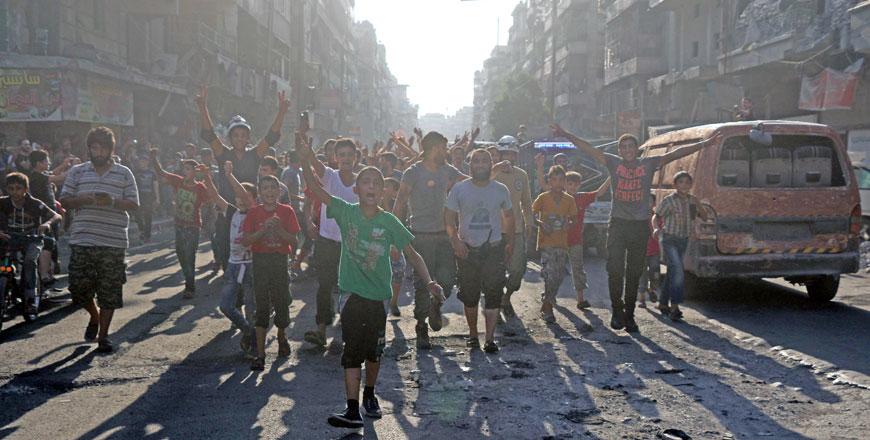You are here
30,000 flee east Aleppo, Russia proposing humanitarian corridors — UN
By Reuters - Dec 01,2016 - Last updated at Dec 01,2016

Syrians living in Aleppo flee the city due to reported air strikes by the regime forces on Thursday (Anadolu Agency photo)
GENEVA — About 30,000 people are receiving aid after fleeing the besieged eastern zone of Aleppo in the past few days, taking the total number of displaced people in the Syrian city to more than 400,000, UN Special Envoy Staffan de Mistura said on Thursday.
By Wednesday, about 18,000 people had been registered entering government controlled areas and about 8,500 crossing into Sheikh Maqsoud, the Kurdish-controlled zone of Aleppo, de Mistura's humanitarian adviser Jan Egeland told reporters. He said those figures were likely to have risen on Thursday.
A ground and air campaign by Syrian government forces and their Russian and Lebanese allies that began in September has cut off rebels in their most important urban stronghold, and left around 250,000 civilians with rapidly dwindling food and medical facilities.
On Sunday and Monday the city's rebels suffered their biggest reverse in four years, losing around a third of the area they had controlled.
Syria and Russia have declined a United Nations request for a pause in the fighting to evacuate 400 sick and wounded in need of immediate treatment, but Russia wants to discuss the idea of setting up four humanitarian corridors, Egeland said, adding:
“A humanitarian corridor can work if all the armed actors respect it.”
The United Nations has food for 150,000 people ready in western Aleppo but it still cannot reach roughly 200,000 who remain in the enclave, where food stocks have run out and surgery is being done in basements without anaesthetic, he said.
Most vulnerable on earth
The United Nations is scaling up its presence in western Aleppo to help with the aid effort but also to monitor the treatment of people fleeing the besieged zone.
“There are no more vulnerable people on Earth, probably, than the civilian population in Aleppo,” said Egeland. “And they are extremely vulnerable for possible actions by the armed opposition groups as they try to leave and by all of the groups that will meet them as they leave.”
The International Committee of the Red Cross (ICRC) is in talks with the Syrian government to gain access to people being screened or detained after fleeing the siege, a senior ICRC official told Reuters.
Although 30,000 were known to have fled to the western sector, countless others were likely to have escaped in other directions, and the number could rise by tens of thousands, the ICRC said in a statement.
Egeland said the top priority remained a pause in the fighting, as well as finding shelter for people as winter begins.
De Mistura renewed his call for the members of the militant group formerly known as Al Nusra Front to leave the besieged zone, which he said would help save lives and strengthen the argument for a ceasefire.
Elsewhere in Syria, aid convoys reached the four besieged towns of Foua, Kufreya, Madaya and Zabadani this week. But overall, only 8 per cent of Syria’s besieged population received aid in November. The United Nations’ convoy plan for December has not yet been approved by the government, Egeland said.
Related Articles
GENEVA — After helping bring aid to 110,000 people in besieged areas in Syria, the UN expressed optimism Thursday that hundreds of thousands
GENEVA — The United Nations called on Tuesday for an urgent ceasefire in the divided Syrian city of Aleppo, where it said 2 million people l
ALEPPO, Syria — More than 50,000 Syrians have joined a growing exodus of terrified civilians from east Aleppo, a monitor said Wednesday, as
















